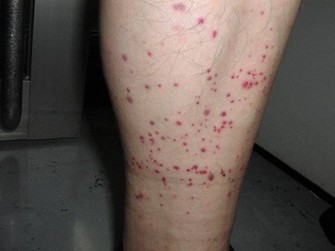Our Terms & Conditions | Our Privacy Policy
Japan expert offers tips to avoid bedbug bites as summer approaches
A bedbug is seen on the wooden frame of a bed in this photo provided by the Ikebukuro Public Health Center in Tokyo.
TOKYO — As temperatures rise and summer draws near, insect-related damage increases. Among these pests, there has been a surge in consultations about bedbugs with extermination companies and industry associations in Japan in recent years. These insects cause intense itching when they bite, and you might unknowingly bring them back with you from your travels. What precautions can one take to avoid being affected?
Human blood as sustenance
There has been a spate of complaints posted on X (formerly Twitter), such as, “I thought it was insanely itchy, turns out it was caused by bedbugs in my futon,” and, “I threw out the carpet to get rid of them.”
Bedbugs, which prefer warm environments, find spring to summer to be the most “comfortable” time of year. Their breeding also becomes more active at this time. Bedbugs are reddish-brown insects, measuring 5 to 8 millimeters in length. They dislike light and are commonly found in dark areas like bedrooms. During the day, they hide in crevices such as the edges of bed mattresses, curtain folds and inside electrical outlets.

Bedbug droppings are seen as black spots on a mattress, indicating that the pests inhabit nearby, in this photo provided by the Ikebukuro Public Health Center.
The troublesome aspect is that bedbugs primarily feed on human blood. While they are not known to transmit viruses, their bites result in a red rash accompanied by intense itching. The itching can disrupt sleep and, in rare cases, lead to severe allergic reactions.
Complete extermination difficult
In Japan, bedbug infestations had nearly disappeared by the late Showa era (1926-1989), but reports of incidents began to resurface in the 2000s. This resurgence is thought to be attributable to the globalization of the movements of people and goods, which has increased the likelihood of bedbugs being brought in from overseas. Furthermore, bedbugs have a relatively long lifespan for an insect of several months to a year, and a single bedbug lays around 500 eggs.
While high-temperature steam and freezing-type insecticides are effective, bedbugs’ high reproductive capability makes complete eradication difficult. Preventing them from being brought home from places like accommodation sites is crucial.

Bedbug bites are seen on a human leg in this photo provided by the Ikebukuro Public Health Center.
Increased consultations with exterminators
Hotels and inns are also taking steps to combat bedbugs.
The pest control company Asante, based in Tokyo’s Shinjuku Ward, has been using bedbug detection dogs since 2010 and continues to train them.
During a session, a 10-year-old male beagle began sniffing the scents of six lidded cups at the command, “Seek!” Within minutes, he sat in front of one cup and nodded his head. When the handler opened the lid, a case containing bedbugs appeared.

A bedbug detection dog searches a cup containing the insect in a training session at the pest control company Asante in Tokyo’s Shinjuku Ward, May 22, 2025. (Mainichi/Richi Tanaka)
Excluding the COVID-19 pandemic period, the company had been inspecting approximately 2,900 rooms at hotels and other facilities annually. In fiscal 2024, the number of requests increased to cover about 3,900 rooms.
According to a survey by the Japan Pest Control Association, an industry group knowledgeable about pest and vermin control and damage prevention, the number of consultations had remained at around 500 to 700 cases since fiscal 2014, but it roughly doubled to 1,176 cases in fiscal 2023.
“From my perspective, I think it’s not so much that the damage has suddenly increased as that awareness and interest have grown,” Asante’s dog handler Ataru Shimoyama noted.
Precautions to take at accommodation sites

A bedbug is seen in this photo provided by the pest control company Asante.
What can be done to prevent infestations? According to Shimoyama, upon arriving at your accommodation, the first step is to check for small black stains around the bed. These could be bedbug droppings.
Additionally, taking advantage of bedbugs’ aversion to light by sleeping with the lights on can be effective. Shimoyama added, “Pretending to sleep is also effective.” Apparently, after about 15 minutes, bedbugs around the bed can be lured out. If you find any, report it to the facility immediately.
At accommodation sites, it’s advisable to place your luggage in the bathroom. Bathrooms, with their slippery materials like tiles, are difficult for bedbugs to navigate as they have weak claws to infiltrate, preventing them from attaching to your belongings.
Preventing them from being brought home

A bedbug is seen inside an electrical outlet in this photo provided by the Ikebukuro Public Health Center.
To avoid bringing bedbugs home from your travels, it is crucial to take precautions immediately upon returning. Keeping your suitcase at the entrance rather than bringing it into the bedroom or living room reduces the likelihood of infestation. Since bedbugs might cling to the inside of your suitcase, it is safer to wash items like clothes at a laundromat with high-temperature dryers rather than at home.
In the unfortunate event that you do bring bedbugs home with you, capture them with adhesive tape and consult a professional exterminator. If an exterminator cannot be arranged immediately, placing adhesive pest traps in the corners of the room can apparently help in extermination.
(Japanese original by Richi Tanaka, Digital News Group)
Images are for reference only.Images and contents gathered automatic from google or 3rd party sources.All rights on the images and contents are with their legal original owners.



Comments are closed.